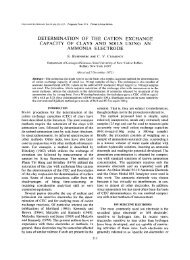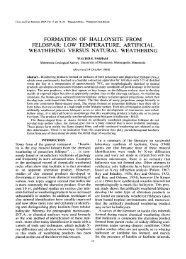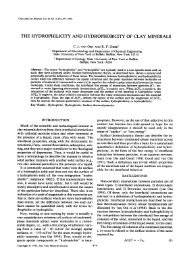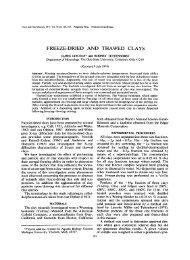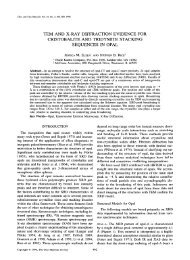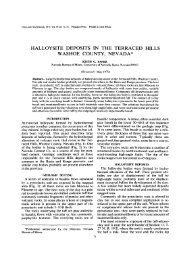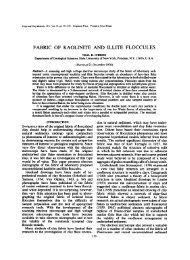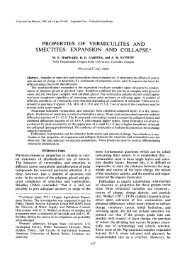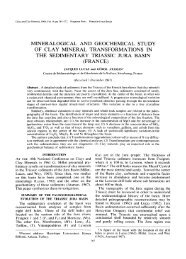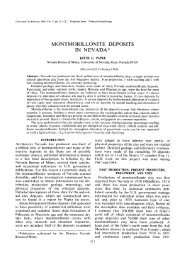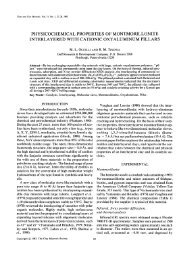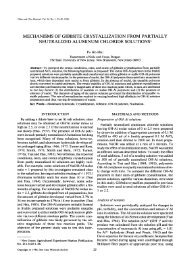Cation-exchange capacity (cec) of zeolitic - Clay Minerals Society
Cation-exchange capacity (cec) of zeolitic - Clay Minerals Society
Cation-exchange capacity (cec) of zeolitic - Clay Minerals Society
Create successful ePaper yourself
Turn your PDF publications into a flip-book with our unique Google optimized e-Paper software.
Vol. 47, No. 6, 1999 CEC <strong>of</strong> zeolites: ammonium acetate saturation 691<br />
Figure 3. Geological map <strong>of</strong> Polyegos island (Kanaris,<br />
1989).<br />
and diluted with 200 mL <strong>of</strong> NH3-free deionized water.<br />
One gram <strong>of</strong> granulated zinc (a few fragments <strong>of</strong> po-<br />
rous porcelain are suitable also) was added to the flask<br />
to promote regular ebullition in the subsequent distil-<br />
lation. An amount <strong>of</strong> 100 mL <strong>of</strong> 0.1 N HC1 was placed<br />
in the receiver. The flask was adjusted so the end <strong>of</strong><br />
the condenser just dips into the acid. An amount <strong>of</strong><br />
100 mL <strong>of</strong> 10% NaOH was placed in the funnel above<br />
the distillation flask. The 10% NaOH was quickly in-<br />
troduced to the distillation flask; when all the alkali<br />
passed, the tap was securely closed. The addition <strong>of</strong><br />
the 10% NaOH produced the complete conversion <strong>of</strong><br />
the NH4 + ions to NH 3 by: NH4 + + OH ~ NH 3 +<br />
H20. The contents <strong>of</strong> the flask were boiled gently for<br />
1 h and all the NH3 passed through to the HC1 <strong>of</strong><br />
the receiver. The tap was opened before switching <strong>of</strong>f<br />
the heating unit, the top <strong>of</strong> the condenser disconnected,<br />
and the receiver lowered and rinsed with deionized<br />
water. A few drops <strong>of</strong> methyl red or a mixture <strong>of</strong> meth-<br />
yl red-bromocresol green was added in the receiver<br />
flask. The excess <strong>of</strong> HC1 in the receiver was measured<br />
by titration using 0.1 N NaOH. The accuracy <strong>of</strong> the<br />
distillation experiments was determined by comparing<br />
to standard 1 M NH4C1 solutions.<br />
Ammonia electrode technique<br />
In aqueous solutions, the potential recorded by an<br />
ammonia electrode is related to the activity <strong>of</strong> the dis-<br />
solved NH3. Thus, NH4 + may be ana/yzed as follows.<br />
The solutions <strong>of</strong> NH4 + are treated with strong NaOH<br />
and converted to NH3, which then may be analyzed by<br />
the ammonia electrode. This technique is much less te-<br />
dious than distillation. The ammonia electrode is con-<br />
nected either to a pH meter or to an ion meter/analyzer,<br />
and a small magnetic stirrer (air-driven stirrers are not<br />
recommended). For the use <strong>of</strong> a pH meter, a calibration<br />
curve <strong>of</strong> known NH 3 concentrations vs. mV (potential)<br />
is first determined. The concentration <strong>of</strong> Nil 3 is then<br />
estimated using the calibration curve. An ion meter/<br />
analyzer measures directly the concentration <strong>of</strong> NtI 3. In<br />
this study, an Orion 95-12 ammonia electrode, and a<br />
Jenway 3045 pH/mV#C/ion analyzer were used. To<br />
convert NH4 + to NH3, 50 mL <strong>of</strong> solution <strong>of</strong> NH4 § were<br />
added to a 100-mL Pyrex beaker containing a Teflon<br />
covered stimng bar. The ammonia electrode was im-<br />
mersed into the solution and no entrapment <strong>of</strong> air under<br />
the concave tip was allowed. Stirring was commenced<br />
and 0.5 mL <strong>of</strong> 10 M NaOH was added by syringe.<br />
Recordings <strong>of</strong> the NH 3 content were obtained at 0.5-<br />
min intervals until a constant level was achieved. The<br />
electrode was calibrated every 2 h using standard<br />
NH4C1 solutions <strong>of</strong> 1, 0.1, 0.01, 0.001, and 0.0001 M.<br />
The accuracy <strong>of</strong> the measurements was determined by<br />
comparing to standard 1 M NH4C1 solutions.<br />
An advantage <strong>of</strong> the ammonia electrode technique<br />
is that NHa+-saturated samples may be used without<br />
prior washing with 10% NaC1. The measurement <strong>of</strong><br />
CEC is both simple and rapid. In this study, NH4 + ions<br />
<strong>of</strong> the zeolites were analyzed also, but without wash-<br />
ing the samples <strong>of</strong> the NH4+-saturated zeolites with<br />
10% NaC1. An amount <strong>of</strong> 50-150 mg <strong>of</strong> the samples<br />
<strong>of</strong> NH4 + saturated zeolites was placed in a 100-mL<br />
Pyrex beaker containing a Teflon covered stirring bar,<br />
Deionized water (50 mL) was added and the solution<br />
stirred to suspend the sample. The electrode was im-<br />
mersed into the suspension taking care to prevent en-<br />
trapment <strong>of</strong> air under the concave tip. An amount <strong>of</strong><br />
0.5 mL <strong>of</strong> 10 M NaOH was added by syringe and<br />
analyses <strong>of</strong> NH3 were taken at 0.5-min intervals until<br />
a constant level was achieved. The electrode was cal-<br />
ibrated every 2 h using NH4C1 solutions <strong>of</strong> 1, 0.1,<br />
0.01, 0.001, and 0.0001 M. The accuracy <strong>of</strong> the mea-<br />
surements was determined by comparing to standard<br />
1 M NH4C1 solutions.<br />
RESULTS AND DISCUSSION<br />
Exchangeable cations measured by ICP-MS after<br />
each saturation cycle are given in Table 1. The 8-d<br />
saturation period was sufficient to <strong>exchange</strong> Ca and<br />
Mg from the zeolites; the analyses for Ca and Mg after<br />
9 d were extremely low. The results from the Santorini<br />
samples are consistent with the mineralogy where the<br />
tuffs are dominated by Na, K-rich clinoptilolites and<br />
Ca and Mg are lower in amount. The results show that<br />
Na and K account for 70-95% <strong>of</strong> the total <strong>exchange</strong>-<br />
able cations in the Santorini samples.<br />
For the Polyegos samples, Na and K also dominate.<br />
They account for 84 to 91% <strong>of</strong> the total <strong>exchange</strong>able<br />
cations, whereas Ca and Mg account for only 9-16%<br />
<strong>of</strong> the <strong>exchange</strong>able cations in samples P5, P8, P10,<br />
P13, and P21. The release <strong>of</strong> low amounts <strong>of</strong> Ca and<br />
Mg suggests that most <strong>of</strong> Ca and Mg may be fixed in<br />
mordenite or fixed relative to NH4 § The high amount



